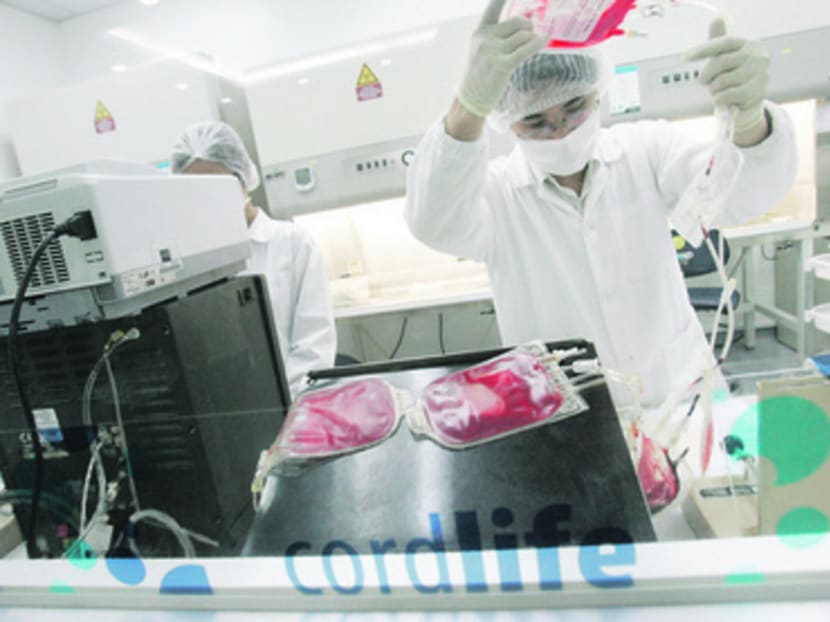Privately-banked cord blood’s low rate of use calls into question its necessity
SINGAPORE — Storing umbilical cord blood in private banks has become a popular form of “biological insurance” against illnesses in recent years, but low rate of use of the stored blood has called into question the necessity of such a service.

Cordlife, Singapore’s biggest private cord blood bank, now stores 168,000 cord blood units for parents in six countries. TODAY file photo
SINGAPORE — Storing umbilical cord blood in private banks has become a popular form of “biological insurance” against illnesses in recent years, but low rate of use of the stored blood has called into question the necessity of such a service.
Medical professionals are instead encouraging parents to consider donating to a public bank instead of storing cord blood out of insecurity.
The process takes blood that remains in the umbilical cord and placenta after childbirth — which is otherwise discarded — and stores it for a fee in a private blood bank.
The blood, which is rich in stem cells that can make every type of blood cell, may be retrieved if the child or a family member develops diseases such as leukaemia, lymphoma and other blood disorders, as well as immune deficiencies and metabolic disorders.
Generally, blood or haematopoietic stem cell transplants can use either the patient’s own stem cells or those from another person.
In advertising their services, the private cord blood banks in Singapore, namely Cordlife, StemCord and Cryoviva, provide statistics to show the chances of a person needing stem cells for treatment in one’s lifetime.
They also highlight the increasing use of stem cells in regenerative therapies — to repair damaged cells or organs — or for conditions such as cerebral palsy and diabetes.
Cordlife, Singapore’s biggest private cord blood bank, now stores 168,000 cord blood units for parents in six countries. StemCord has 38,000 units while Cryoviva has close to 2,000 units.
Dr Chiew Yoke Fong, Cordlife’s medical director, said that “as many as one in 217 people are estimated to require a stem cell transplantation in their lifetime”.
Dr Ashish Munjal, Cryoviva’s chief executive, said his company ensures clients are well-informed about both private and public banking facilities.
Parents who opt for public banks such as the Singapore Cord Blood Bank (SCBB) can donate without charge. Their donated cord blood can be used to treat any patient or their own family members, if the unit is still available.
Parents who use private banks pay to store the blood and it is intended only for the family’s personal use.
There are camps of medical professionals who advocate storing with a public bank, where it benefits a wider pool of patients.
Overseas medical associations such as the American Academy of Pediatrics and the American Society of Blood and Marrow Transplantation have published guidelines encouraging parents to do just that. And they recommend against private banking as an “insurance” or for unidentified possible future use of cord blood.
Doctors here estimate that the chance of families retrieving their privately banked cord blood for treatment is between one in 2,500 (0.04 per cent) and one in 20,000 (0.0005 per cent).
Cord blood stored in the public bank has a 2.2 per cent chance of being used. Cordlife has retrieved 35 units for clients in the region, while StemCord retrieved 12. The SCBB has facilitated 191 transplants since 2006.
The low rate of use for privately banked cord blood is partly because most transplant physicians do not always view the patient’s own cord blood as the best choice.
Associate Professor William Hwang, SCBB’s medical director, explained: “This is because it may already carry the genetic abnormality that led to the blood or immune system failure or cancer in the first place.
Another factor is the small pool of patients needing stem cell transplants. Dr Daryl Tan, a specialist in haematology and a consultant at Raffles Cancer Centre, estimates that childhood leukaemia affects about five children per million per year worldwide.
However, with a cure rate of 80 per cent, only 20 per cent of these patients would need a transplant.
He said: “Even if your sibling’s banked cord blood cells were a full match, I would rather get the fresh specimen of stem cells from the sibling because those cells would be much higher and more effective.”
For children, stem cell transplant is usually not the first line of treatment as well. National University Cancer Institute senior consultant Allen Yeoh said this is because it requires destroying the child’s existing cells to allow the new cells to take root and grow, which may cause long-lasting side effects such as infertility and growth problems.
On the other hand, said StemCord medical director Teo Cheng Peng, advancements in regenerative therapies could see the expanded use of cord blood to treat a greater variety of conditions.
Dr Teo, who is also a senior consultant for haematology at Parkway Cancer Centre, added that he has had patients who were unable to find a match in the public registries and were left with no other options.
Dr Tan acknowledged that private banks would be useful in certain scenarios, such as for patients from minority races who face a smaller chance of finding a match in public registries or for families with a history of blood diseases.
Still, he thinks most people bank out of “insecurity”. He cautioned that results from clinical trials on regenerative therapies could be anecdotal and not “evidence-based” medicine.
The Ministry of Health told TODAY that all cord blood banks are licensed under the Private Hospitals and Medical Clinics Act, which requires them to comply with various regulations for the licensee, facilities, quality control, records and reports, among others.
It added that prospective clients should consult their family doctors or other relevant medical professionals before they subscribe to cord blood banking services or choose their service providers.









